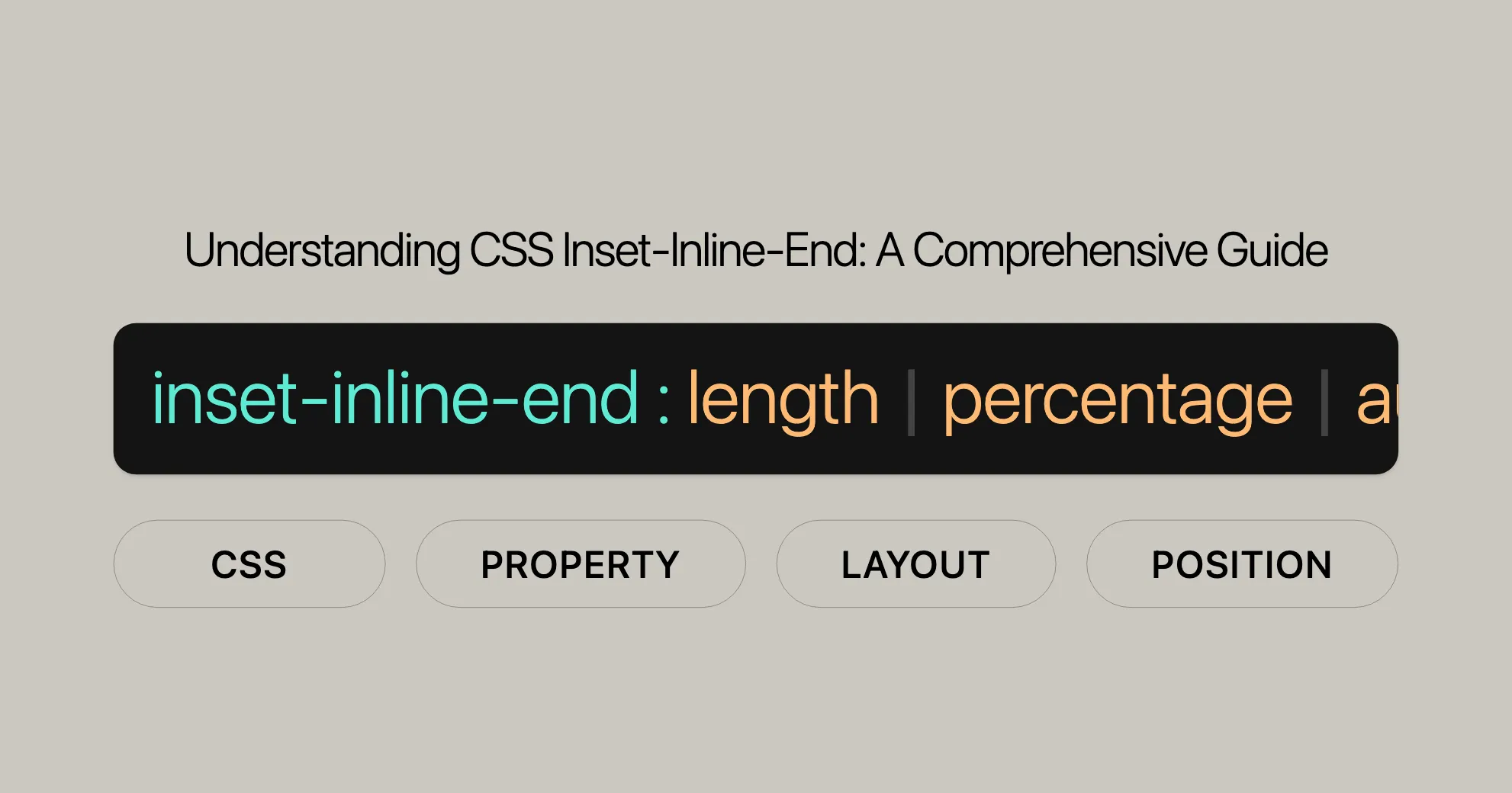- Services
- Case Studies
- Technologies
- NextJs development
- Flutter development
- NodeJs development
- ReactJs development
- About
- Contact
- Tools
- Blogs
- FAQ
Understanding CSS Inset-Inline-End A Comprehensive Guide
Discover its use cases, available options like lengths, percentages, and keywords.
Optimize your web designs with this flexible property.

inset-inline-end CSS Property
The inset-inline-end CSS property defines the logical inline end inset of an element. It helps position elements based on their writing mode, directionality, and text orientation, making it a powerful tool for responsive and adaptable design.
Syntax
Here’s how you can use the inset-inline-end property:
/* Length values */inset-inline-end: 3px;inset-inline-end: 2.4em;
/* Percentage values */inset-inline-end: 10%;
/* Keyword value */inset-inline-end: auto;
/* Global values */inset-inline-end: inherit;inset-inline-end: initial;inset-inline-end: revert;inset-inline-end: revert-layer;inset-inline-end: unset;Values
- Length Values: Use fixed lengths like pixels (
px) or ems (em). - Percentage Values: Set the inset as a percentage of the containing block’s width or height.
- Keyword Values:
autolets the browser determine the inset. - Global Values: Use
inherit,initial,revert,revert-layer, andunsetfor inheritance and resetting.
Formal Definition
The inset-inline-end property is part of CSS Logical Properties and Values Level 1, aimed at making CSS more adaptable to different writing modes and directionalities.
- Initial Value:
auto - Applies To: Positioned elements (
relative,absolute,fixed,sticky) - Inherited: No
- Percentages: Calculated based on the logical width of the containing block
Examples
Basic Usage
HTML:
<div> <p class="exampleText">Example text</p></div>CSS:
div { background-color: yellow; width: 120px; height: 120px;}
.exampleText { position: relative; inset-inline-end: 20px; background-color: #c8c800;}Vertical Writing Mode
HTML:
<div> <p class="exampleText">Example text</p></div>CSS:
div { background-color: yellow; width: 120px; height: 120px;}
.exampleText { writing-mode: vertical-rl; position: relative; inset-inline-end: 20px; background-color: #c8c800;}Using Percentage Values
HTML:
<div> <p class="exampleText">Example text</p></div>CSS:
div { background-color: yellow; width: 200px; height: 100px;}
.exampleText { position: relative; inset-inline-end: 10%; background-color: #c8c800;}Browser Compatibility
The inset-inline-end CSS property is widely supported across modern web browsers, making it a reliable choice for web developers. This property has been available since September 2021, ensuring compatibility with many devices and browser versions.
Supported Browsers
- Google Chrome: Version 87 and above
- Firefox: Version 63 and above
- Microsoft Edge: Version 87 and above
- Opera: Version 73 and above
- Safari: Version 14.1 and above
Browser Compatibility Table
| Browser | Version |
|---|---|
| Google Chrome | 87+ |
| Firefox | 63+ |
| Microsoft Edge | 87+ |
| Opera | 73+ |
| Safari | 14.1+ |
Additional Resources
For a more comprehensive understanding of CSS properties and their usage, you might want to explore the following related properties and resources:
-
Other Inset Properties:
-
Mapped Physical Properties:
-
Writing Mode and Direction Properties:
-
Related Specifications:
-
Additional Resources:
These resources will provide you with a deeper understanding of how to use CSS properties effectively, including the inset-inline-end property. By exploring these related properties and resources, you can enhance your web development skills and create more sophisticated and responsive web designs.
 สร้างเว็บไซต์ 1 เว็บ ต้องใช้งบเท่าไหร่? เจาะลึกทุกองค์ประกอบ website development cost อยากสร้างเว็บไซต์แต่ไม่มั่นใจในเรื่องของงบประมาณ อ่านสรุปเจาะลึกตั้งแต่ดีไซน์, ฟังก์ชัน และการดูแล พร้อมตัวอย่างงบจริงจาก Till it’s done ที่แผนชัด งบไม่บานปลายแน่นอน
สร้างเว็บไซต์ 1 เว็บ ต้องใช้งบเท่าไหร่? เจาะลึกทุกองค์ประกอบ website development cost อยากสร้างเว็บไซต์แต่ไม่มั่นใจในเรื่องของงบประมาณ อ่านสรุปเจาะลึกตั้งแต่ดีไซน์, ฟังก์ชัน และการดูแล พร้อมตัวอย่างงบจริงจาก Till it’s done ที่แผนชัด งบไม่บานปลายแน่นอน  Next.js สอน 14 ขั้นตอนเบื้องต้น: สร้างโปรเจกต์แรกใน 30 นาที เริ่มต้นกับ Next.js ใน 14 ขั้นตอนเพียงแค่ 30 นาที พร้อม SSR/SSG และ API Routes ด้วยตัวอย่างโค้ดง่าย ๆ อ่านต่อเพื่อสร้างโปรเจ็กต์แรกได้ทันทีที่นี่
Next.js สอน 14 ขั้นตอนเบื้องต้น: สร้างโปรเจกต์แรกใน 30 นาที เริ่มต้นกับ Next.js ใน 14 ขั้นตอนเพียงแค่ 30 นาที พร้อม SSR/SSG และ API Routes ด้วยตัวอย่างโค้ดง่าย ๆ อ่านต่อเพื่อสร้างโปรเจ็กต์แรกได้ทันทีที่นี่  วิธีสมัคร Apple Developer Account เพื่อนำแอปขึ้น App Store ทีละขั้นตอน อยากปล่อยแอปบน App Store ระดับโลก มาอ่านคู่มือสมัคร Apple Developer Account พร้อมเคล็ดลับ TestFlight และวิธีอัปโหลดที่ง่ายในบทความเดียวนี้ได้เลย
วิธีสมัคร Apple Developer Account เพื่อนำแอปขึ้น App Store ทีละขั้นตอน อยากปล่อยแอปบน App Store ระดับโลก มาอ่านคู่มือสมัคร Apple Developer Account พร้อมเคล็ดลับ TestFlight และวิธีอัปโหลดที่ง่ายในบทความเดียวนี้ได้เลย  TypeScript Interface คืออะไร? อธิบายพร้อมวิธีใช้และข้อแตกต่างจาก Type เรียนรู้วิธีใช้ TypeScript Interface เพื่อสร้างโครงสร้างข้อมูลที่ปลอดภัยและเข้าใจง่าย พร้อมเปรียบเทียบข้อดีข้อแตกต่างกับ Type ที่คุณต้องรู้ ถูกรวมเอาไว้ในบทความนี้แล้ว
TypeScript Interface คืออะไร? อธิบายพร้อมวิธีใช้และข้อแตกต่างจาก Type เรียนรู้วิธีใช้ TypeScript Interface เพื่อสร้างโครงสร้างข้อมูลที่ปลอดภัยและเข้าใจง่าย พร้อมเปรียบเทียบข้อดีข้อแตกต่างกับ Type ที่คุณต้องรู้ ถูกรวมเอาไว้ในบทความนี้แล้ว  Material-UI (MUI) คืออะไร อยากสร้าง UI สวยงามและเป็นมืออาชีพในเวลาอันรวดเร็วใช่ไหม มาทำความรู้จักกับ Material-UI (MUI) ที่ช่วยให้คุณพัฒนาแอปพลิเคชันบน React ได้ง่ายและดูดีในทุกอุปกรณ์
Material-UI (MUI) คืออะไร อยากสร้าง UI สวยงามและเป็นมืออาชีพในเวลาอันรวดเร็วใช่ไหม มาทำความรู้จักกับ Material-UI (MUI) ที่ช่วยให้คุณพัฒนาแอปพลิเคชันบน React ได้ง่ายและดูดีในทุกอุปกรณ์  เปรียบเทียบ 3 วิธีติดตั้ง install node js บน Ubuntu: NVM vs NodeSource vs Official Repo แบบไหนดีที่สุด? เรียนรู้วิธีติดตั้ง Node.js บน Ubuntu ด้วย NVM, NodeSource หรือ Official Repo เลือกวิธีที่เหมาะกับความต้องการของคุณ พร้อมเปรียบเทียบ เพื่อการพัฒนาที่มีประสิทธิภาพ!
เปรียบเทียบ 3 วิธีติดตั้ง install node js บน Ubuntu: NVM vs NodeSource vs Official Repo แบบไหนดีที่สุด? เรียนรู้วิธีติดตั้ง Node.js บน Ubuntu ด้วย NVM, NodeSource หรือ Official Repo เลือกวิธีที่เหมาะกับความต้องการของคุณ พร้อมเปรียบเทียบ เพื่อการพัฒนาที่มีประสิทธิภาพ! Talk with CEO
We'll be right here with you every step of the way.
We'll be here, prepared to commence this promising collaboration.
Whether you're curious about features, warranties, or shopping policies, we provide comprehensive answers to assist you.


